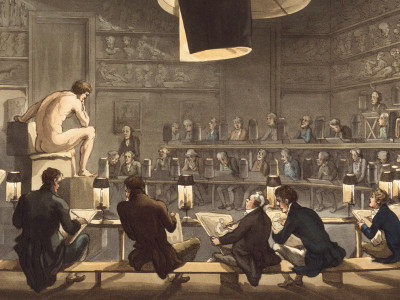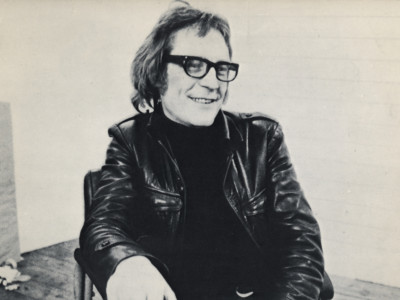
Should there be positive discrimination towards female artists?
By Eileen Cooper RA and Helena Morrissey
Published on 21 May 2014
Eileen Cooper RA and Helena Morrissey discuss whether art institutions need to prioritise women to achieve gender equality or whether positive discrimination is counter-productive.
From the Summer 2014 issue of RA Magazine, issued quarterly to Friends of the RA.
Yes…
More women than men are studying art, but once they leave art school they are having less exposure and success. In 2011-12, 62 per cent of arts and design students in the UK were female. But in the same year, according to one audit, 31 per cent of London’s galleries presented work by women.
Of works by living artists acquired by Tate last year, 21 per cent were by women*, and a similar proportion of the current 125 Royal Academicians are women. So unless you think women make worse art, you must conclude that the art world fails female artists.
This is not to obscure the many successes of female artists. As Keeper of the Royal Academy, I am responsible for the RA Schools and I am always very pleased to see the success of our female graduates, such as painter Lynette Yiadom Boakye, who was nominated for last year’s Turner Prize. We are lucky that the RA Schools attracts a large number of both male and female applicants, and there is consequently a rough gender balance in artists we interview and select for the course. This does not occur through any policy but through the quality of the applicants who are out there.
We should, of course, think about the issues women of all professions face. But the art world has one unique challenge: art history. Contemporary artists are in constant dialogue with art history and, as a generalisation, art history is overwhelmingly about male artists. Although there is a very welcome, growing number of shows and books emphasising art made by women, the majority draw from the male canon. As we walk through the streets we are faced with art by men: in Westminster and the City less than one in 10 public artworks is made by a woman. No wonder our idea of an artist follows macho stereotypes – Renaissance man, tortured hero, the protean, philandering Picasso.
We can only do so much about the past. My worry is that unless we challenge preconceptions today as strongly as possible, in 100 years’ time younger generations will look upon 21st-century art as a male pursuit in the same way that we now regard earlier art. It is for this reason that institutions, including the RA, should consider some type of quota, formal or informal. As Chris Orr RA explains in this issue, the Academy’s artists elect themselves democratically. There is no conscious discrimination, but people naturally tend to vote for those similar to themselves, and at the RA that often means men.
A short period of prioritisation would allow the achievements of female artists to be visible in the future.
Eileen Cooper RA
We need to find a way to break that pattern in terms of gender, and ethnicity as well, otherwise we will look like a gentlemen’s club. We need to prioritise women in our elections over the next few years. This doesn’t mean never voting for men, but it does mean aiming for a gender balance in the near future.
We should also consider gender in the RA’s exhibition programme, as our monographic shows are pretty much always by men. I’m sure there are worries that putting on an exhibition by a female artist, who may be less well known, is not financially viable, but this creates a vicious circle, as women artists will never become more well known if they are rarely exhibited.
Many will argue that positive discrimination would not select the best artists. That presupposes a lack of outstanding artists in the female half of the population – but outstanding women are overlooked and we need to work harder to bring them to attention. Some might see any positive discrimination as a tainted process, but the quality of the work would shine through and most artists would see the bigger picture. A short period of prioritisation would allow the achievements of female artists to be visible in the future and help encourage us to present more art by women. Why wouldn’t you want actively to present alternative, female views of the world? Wouldn’t it be more interesting if our exhibitions and collections were representative of all the issues and perspectives in this country?
* The statistic about the Tate’s acquisitions refers to the number of works by female living artists for 2012-13. Tate has clarified that, instead of counting number of works, it accounts for gender representation in the Tate Collection by counting the number of artists represented in each year’s acquisitions. By this metric, 36% of living artists collected in 2012-13 were women.
No...
The gender imbalance in the art world is the same as that within the business world, and this is an issue that resonates with me for many reasons. As well as being Chair of the RA’s Corporate Board and the Chief Executive of Newton Investment Management – a company that sponsors the RA Schools – I am the founder of the Thirty Per Cent Club, a group of senior business leaders aiming for at least 30 per cent of FTSE-100 board directors to be women by the end of 2015.
Many disciplines are now working towards achieving a better gender balance – in fact it is now less a case of questioning whether it is important and more one of asking how we can achieve it. There are over 90 members of the UK Thirty Per Cent Club, mostly men who are working together with women to effect change. We decided 30 per cent is a realistic objective (when we launched in 2010, representation was 12.6 per cent) and there is evidence that 30 per cent is a critical mass. Our work includes many initiatives to encourage women and change cultures in the workplace.
However, we have a policy against positive discrimination. I am against anything mandatory, all-women shortlists, or any kind of social engineering. I would be very reluctant to appoint a woman just as a way of balancing the numbers, as it would disadvantage men, which is just another kind of injustice. It would potentially be counter-productive to have women on boards who were not qualified or, in the context of the art world, women represented in exhibitions, collections or institutions who did not deserve to be there. I think that it could backfire and diminish British art. Norway legislated in 2003 to ensure at least 40 per cent of board members are female, but in 2014 there are no female CEOs in the country’s 25 biggest companies. I’m after sustainable, meaningful change.
Our method is called soft power - persuading people to want the same objective, then working together.
Helena Morrissey
Our method is what you could call ‘soft power’ – persuading people to want the same objective and then working together to achieve it. An example of how this works was when a colleague gave me an all-male shortlist of candidates for a job. I said, ‘Were there no women who were qualified?’ And he said, ‘Well, there was one woman, but she has four children.’ I told him he was making assumptions about her ambition, enthusiasm and commitment that might not be true. He agreed and we interviewed the woman. We didn’t think she was quite as good as one of the men for the job – she was the runner-up. My colleague admitted afterwards that he had an unconscious bias and needed a nudge.
Art institutions should do a similar thing on a systematic basis, cross-checking that women have been treated at least as well as the men. The art world also needs to analyse what’s going on in detail, asking why there is a majority of women studying art but a majority of men becoming successful artists. What happens after art school, and what can be done to change circumstances? In business we have seen specific programmes around maternity leave, assertiveness and mentoring – initiatives that have been necessary but not sufficient. Subconscious behaviour also needs to be addressed and we aim to change this with the support and involvement of men.
Our approach has seen a very accelerated pace of change since 2010. In March, representation on FTSE-100 boards was 20.8 per cent. Soft power works, but it is not easy. You need to access the levers of power, networking with the leaders in the field. Warren Buffett, a legend in the investment world, has written a very supportive endorsement of the recently launched US version of the Thirty Per Cent Club and that has encouraged other business leaders to get involved – people need inspiration from somebody they respect. There could be a Thirty Per Cent Club for art, comprising the major powerful figures in the art world, to create a movement for change.
Related articles

Visions from Ukraine
19 June 2024

10 RA Schools stories through the centuries
16 May 2024

In memoriam: Mick Moon RA
1 May 2024